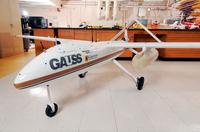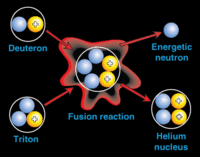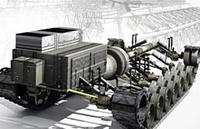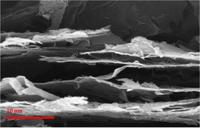-
Metamaterial sensor improves security, collision avoidance

Engineers have developed a novel sensor which is more efficient, versatile, and cheaper for potential use in such applications as airport security scanners and collision avoidance systems for aircraft, cars, or maritime vessels.
-
-
Police experience enlivens classroom teaching
Dennis Marsili spent twenty-seven years as a police officer in the Pittsburgh area, and has attained a vast amount of knowledge which he is now passing on to people who want to work in law enforcement in the future.
-
-
Aerial platform helps in developing lightweight sensors for UAVs

A research team at the Georgia Tech Research Institute (GTRI) is developing an airborne testing capability for sensors, communications devices, and other airborne payloads. This aerial test bed, called the GTRI Airborne Unmanned Sensor System (GAUSS), is based on an unmanned aerial vehicle (UAV) made by Griffon Aerospace and modified by GTRI.
-
-
Global demand for food and energy is growing, and so does land and water “grabbing”

As world food and energy demands grow, nations and some corporations increasingly are looking to acquire quality agricultural land for food production. Some nations are gaining land by buying up property — and accompanying water resources — in other, generally less wealthy countries.
-
-
The humble jute serves as a sustainable reinforcement for concrete
Fashionable people may turn up their noses at jute, the cheap fiber used to make burlap, gunny sacks, twine, and other common products, but new research is enhancing jute’s appeal as an inexpensive, sustainable reinforcement for mortar and concrete.
-
-
New design for clean nuclear fusion reactor unveiled

Researchers have patented a nuclear fusion reactor by inertial confinement which, in addition to being used to generate electric power in plants, could be applied to propel ships. The fusion chamber shape and size can adapt to the type of fuel being used.
-
-
Social media helped but did not cause Arab Spring

Social psychological research has concluded that social media accelerated but did not cause the Arab Spring uprisings in Tunisia and Egypt.
-
-
Military systems hibernate on the sea floor, then woken up remotely
Almost half of the world’s oceans are more than four kilometers deep. This provides considerable opportunity for cheap stealth, but the vastness and depth make retrieval costs prohibitive. DARPA wants to developing deployable, unmanned, distributed systems which hibernate on the deep-ocean floor in special containers for years at a time. These deep-sea nodes would then be woken up remotely when needed and recalled to the surface
-
-
DARPA’s first FANG Challenge begun yesterday

More than 700 participants, organized in 150 teams, yesterday begun collaboration to design the mobility and drivetrain systems of a next-generation, amphibious infantry fighting vehicle. The goal of the competition is to compress the design-to-production time of a complex defense system by up to a factor of five.
-
-
Better screening for bacteria for safer food

There are around 5.4 million cases of food-borne gastroenteritis in Australia every year. Of these cases, it is estimated that around 200,000 are associated with the bacteria Campylobacter jejuni and Campylobacter coli. Chicken meat and other foods will be able to be screened for bacteria even faster and more effectively than ever, thanks to breakthrough nanobiotechnology research.
-
-
Global warming threatens U.K. diet
The number of days with temperatures over 32 degrees C has more than doubled in some parts of France over the last fifty years. Many other land areas show similar increases. By the 2020s, temperatures over 32 degrees C could occur over large areas of France where previously they were uncommon. Maize yields are reduced significantly for each day with temperatures over around 32 degrees Celsius. The United Kingdom imports more maize from France than anywhere else in the world, and declining crop yields in France mean that U.K. consumers will have to pay more for maize-based foods, or change their diets.
-
-
Drought, heat turn hundreds of U.S. counties into disaster areas

The U.S. Agriculture Department (USDA) last week said that drought conditions and heat necessitated designating 597 counties in fourteen states as primary natural disaster areas. The affected counties have suffered severe drought for eight consecutive weeks, which qualified them for the automatic designation. 2012 had been the hottest year on record for the continental United States: the year’s average temperature of 55.3 degrees Fahrenheit across the Lower 48, which was more than 3.2 degrees warmer than the average for the twentieth century.
-
-
Neutralizing the effects of lethal chemical agents
Organophosphorus agents (OPs) are used both in farm pesticides, and by terrorists and rogue states. About 200,000 people die each year across the world from organophosphorus agents (OP) poisoning, through occupational exposure, unintentional use, and misuse, mostly in developing countries like India, Pakistan, and Sri Lanka and through deliberate terrorist activities. OPs include compounds like Tabun, which was developed in 1936 by German scientists during the Second World War, Sarin, Soman, Cyclosarin, VX, and VR. Researchers develop an enzyme treatment which could neutralize the effects of OPs.
-
-
Tiny helpers: Atom-thick flakes help clean up radioactive waste, fracking sites

Graphene oxide has a remarkable ability quickly to remove radioactive material from contaminated water. Researchers determined that microscopic, atom-thick flakes of graphene oxide bind quickly to natural and human-made radionuclides and condense them into solids. The discovery could be a boon in the cleanup of contaminated sites like the Fukushima nuclear plants, and it could also cut the cost of hydraulic fracturing (“fracking”) for oil and gas recovery and help reboot American mining of rare earth metals.
-
-
Catching up: Indian and Chinese companies at the forefront of innovation
In a few short years, the Chinese and Indian share of the world’s research and development centers has increased from 8 to 18 percent. A new study says that India and China invest more than the West in organizational innovation, that is, the implementation of a company structure that creates a favorable climate for new inventions.
-
More headlines
The long view
New Technology is Keeping the Skies Safe
DHS S&T Baggage, Cargo, and People Screening (BCP) Program develops state-of-the-art screening solutions to help secure airspace, communities, and borders
Factories First: Winning the Drone War Before It Starts
Wars are won by factories before they are won on the battlefield,Martin C. Feldmann writes, noting that the United States lacks the manufacturing depth for the coming drone age. Rectifying this situation “will take far more than procurement tweaks,” Feldmann writes. “It demands a national-level, wartime-scale industrial mobilization.”
How Artificial General Intelligence Could Affect the Rise and Fall of Nations
Visions for potential AGI futures: A new report from RAND aims to stimulate thinking among policymakers about possible impacts of the development of artificial general intelligence (AGI) on geopolitics and the world order.
Smaller Nuclear Reactors Spark Renewed Interest in a Once-Shunned Energy Source
In the past two years, half the states have taken action to promote nuclear power, from creating nuclear task forces to integrating nuclear into long-term energy plans.
Keeping the Lights on with Nuclear Waste: Radiochemistry Transforms Nuclear Waste into Strategic Materials
How UNLV radiochemistry is pioneering the future of energy in the Southwest by salvaging strategic materials from nuclear dumps –and making it safe.
Model Predicts Long-Term Effects of Nuclear Waste on Underground Disposal Systems
The simulations matched results from an underground lab experiment in Switzerland, suggesting modeling could be used to validate the safety of nuclear disposal sites.
